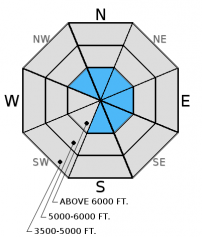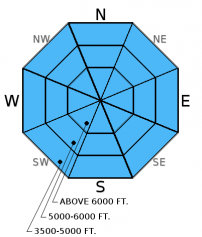| Tuesday | Tuesday Night | Wednesday | |
|---|---|---|---|
| Cloud Cover: | Moderate snow showers with light to moderate winds | Snow tapering | Snow redeveloping |
| Temperatures: | 22-31 deg. F. | 9-19 deg. F. | 19-28 deg. F. |
| Wind Direction: | W | SW | SW |
| Wind Speed: | 6-11 gusts 22 | 7-10 gusts 21 | 5-8 |
| Snowfall: | 1-4 in. | 0-1 in. | 1-4 in. |
| Snow Line: |
Whitefish Range
Flathead Range and Glacier National Park
How to read the forecast
Widespread snowfall overnight and today, combined with increasing winds, will create dangerous avalanche conditions today. At all elevations the avalanche danger is CONSIDERABLE. Human triggered avalanches are likely and natural avlanches are possible. Conservative decision making is essential today. Carefully evaluate each slope before commiting to it. Check advisory for Swan Range here.

3. Considerable
?
Above 6500 ft.
3. Considerable
?
5000-6500 ft.
3. Considerable
?
3500-5000 ft.
- 1. Low
- 2. Moderate
- 3. Considerable
- 4. High
- 5. Extreme
-
Type ?
-
Aspect/Elevation ?

-
Likelihood ?CertainVery LikelyLikelyPossible
 Unlikely
Unlikely -
Size ?HistoricVery LargeLargeSmall

The combination of low density snowfall overnight coupled with a forecast of increasing winds today will make conditions favorable for fresh wind slab development throughout the day. At the beginning of the storm winds were from a north though easterly direction and therefore be aware of atypical loading patterns that occured early in this storm. Today should be a great day for identifying wind slabs. Look for obvious signs of instability like cracking and collapsing in denser pockets of snow. Continue to carefully evaluate wind-loaded areas before skiing or riding the slope. Wind slabs are easy to identify, look for smooth, convex pillows along leeward ridgelines and cross-loaded gullies.
-
Type ?
-
Aspect/Elevation ?

-
Likelihood ?CertainVery LikelyLikelyPossible
 Unlikely
Unlikely -
Size ?HistoricVery LargeLargeSmall

New snow at all elevations has created a widespread storm slab concern throughout our advisory area. Human triggered avalanches are likely especially on steep convex slopes. Because this is a surface snow problem it is easy to identify. Stick your hand into the new snow and see how this layer is bonding to the recent snow from this weekend. This new snow needs time to stabilize so cautious route finding and conservative decision making are essential today.
-
Type ?
-
Aspect/Elevation ?

-
Likelihood ?CertainVery LikelyLikelyPossible
 Unlikely
Unlikely -
Size ?HistoricVery LargeLargeSmall

The primary persistent slab concern continues to be the weak, faceted snow above and below the Dec. 9 crust. This layer is generally found 2-2.5 feet from the surface and exists in most locations across the advisory area. Today, the strength of this layer will be tested particularly on leeward slopes subject to wind loading. So far, we have not seen avalanche activity associated with this weak snow, but it is hard to say just how much weight it can handle. Continue to dig into the snow and assess this layer before committing to a slope and keep in mind the additional stress we put on this weak snow as we continue in our active weather pattern.
In some locations in the Flathead Range, Glacier Park, and parts of the Swan Range we noted and have received observations of weak, sugary snow near the ground. In some places it breaks and propagates across a column in stability tests (video), and sometimes it doesn't even break. These faceted grains are generally found in areas of thin snowpack and around rocks. With the December 9 rain crust fairly thick in places, it makes affecting these deeper layers more difficult. Though it appears very isolated in distribution, it is worth mentioning that skiers in the southern Whitefish Range found buried surface hoar Sunday which further illustrates the importance of digging in the snow to see what is going on below you.
On both Sunday and Monday BNSF Avalanche Safety reported natural avalanche activity in the John F Stevens Canyon. Sundays avalanches were thin wind slabs (10-12 inches) that failed Saturday night and Sunday morning (observation). Yesterdays observed avalanches (photo) were larger and trigerred by cornice fall. They also observed debris from small cornice failures and continued drifting of snow along the ridgelines.
On Sunday Todd traveled to Red Meadow in the northern Whitefish Range Sunday and found 15-20 inches of snow on top of the Dec. 9 crust. This crust was nearly 5 inches thick (Photo) at 7200 feet and though weak snow existed around the crust it did not fail in stability tests.
Skiers on the Autumn Creek trail in southern Glacier National Park observed wind drifting snow on surrounding peaks. They found the Dec 9 crust was decomposing and 2 feet from the surface (Observation). Other skiers were on Skookoleel Ridge in the southern Whitefish Range and in one location found buried surface hoar that failed and propagated in stability tests (Observation).
Saturday, I was instructing an Intro to Avalanches course just outside of the ski area boundary and found recent storm snow that was settling and strengthening. Weak faceted snow was present below mid-snowpack crusts and failed in stability tests with moderate force.
On Friday, Erich and Todd rode into the Lost Johnny drainage and skied up Hash Mountain where we observed obvious signs of storm and wind slab instability including: cracking, collapsing, and we triggered a couple of soft slab avalanches (photo) from the ridgeline above (Observation, Video).
Visit our Observations page and our You Tube channel for more information from the entire season.
Please let us know what you are seeing out there. Your observations are important and valued.
HOW TO SUBMIT OBSERVATIONS:
Email: [email protected]
Call and leave a message: 406.387.3821
You can also submit quick observations via text: 406.241.4571 (FAC mobile)
OR
Submit Snowpack Observations: http://www.flatheadavalanche.org/node/add/snowobs
Submit Avalanche Observations: http://www.flatheadavalanche.org/node/add/avyobs
The storm currently affecting our advisory area has brought beneficial snowfall to all elevations. Mouintain weather stations are reporting 4-9 inches of new snow with 10" outside our office in Hungry Horse. Noisy Basin received 12 inches of new snow with 1.6 inche of water. Currently temperatures above 6000 feet range from 17º-24º F and light winds have shifted from the north through east to a more westerly direction. Today, snow showers will continue and drop 2-4 inches of snow before tapering off this afternoon. Temperatures should remain in the mid to upper 20s while wind speeds will increase to 5-15 with gusts to 30.
| 0600 temperature: | 18-24 deg. F. |
| Max. temperature in the last 24 hours: | 18-27 deg. F. |
| Average wind direction during the last 24 hours: | N-NE |
| Average wind speed during the last 24 hours: | 5-10 mph |
| Maximum wind gust in the last 24 hours: | 21-35 mph |
| New snowfall in the last 24 hours: | 4-12 inches |
| Total snow depth: | 51-62 inches |
This advisory applies only to backcountry areas outside established ski area boundaries. This advisory describes general avalanche conditions and local variations always occur. This advisory expires at midnight on the posted day unless otherwise noted. The information in this advisory is provided by the USDA Forest Service who is solely responsible for its content.







































